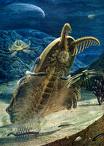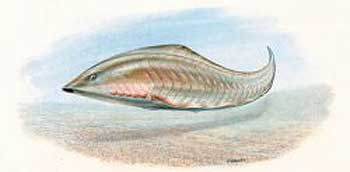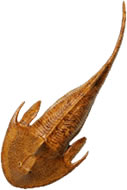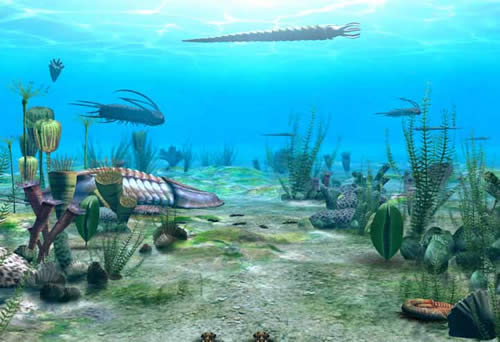Cambrian Period 540 Million Years Ago
 540
Million Years Ago, nothing lives on land, but a different story exists
under the oceans. Evolution has been pulsing slowly and steady for millions
of years. The oceans are filled with simple, soft body organisms, blindly
drifting away with the currents. In the shallow coasts however, evolution
has slowly picked up the pace.
540
Million Years Ago, nothing lives on land, but a different story exists
under the oceans. Evolution has been pulsing slowly and steady for millions
of years. The oceans are filled with simple, soft body organisms, blindly
drifting away with the currents. In the shallow coasts however, evolution
has slowly picked up the pace.
The Anomalocaris has been preying on smaller animals. Anomalocaris is the first super predator during this period. This 4 foot predator is a result of a slow evolutionary move. This animal possessed eye sight, its eyes were composed of many lenses. Other prey and predators possess sight. Being able to see and be seen by other enemies made the evolutionary process more challenging. To combat being visible and vulnerable, many organisms on these shallow seas have developed rigid exoskeletons to protect against the enemy. These armored organisms are called artrhopods. In the future they give rise to both, insects and spiders.
 This
is Haikouichthys, it is named after a place in China where its fossils
were found. It is only the size of your thumb nail, but an evolutionary
giant. Its the first species of fish. It is critical to our evolutionary
line, because of instead of having armor on the outside, it is tough on
the inside. It has a primitive back bone, a notochord which makes it the
very fist vertebrate. He is the forth barer of all backbone animals, from
dinosaurs, to elephants, to humans.
This
is Haikouichthys, it is named after a place in China where its fossils
were found. It is only the size of your thumb nail, but an evolutionary
giant. Its the first species of fish. It is critical to our evolutionary
line, because of instead of having armor on the outside, it is tough on
the inside. It has a primitive back bone, a notochord which makes it the
very fist vertebrate. He is the forth barer of all backbone animals, from
dinosaurs, to elephants, to humans.
Although lacking fins, its flexible backbone makes it more flexible and maneuverable than the spineless Anomalocaris. While these tiny backbone ancestors may have survived among other predators, they must adapt or die out. As millions of years pass by, fish built on their basic design.
 The
muscles on their backbone evolved into a powerful tail, and fins began
to sprout. They also developed a distinct head. These animals may not
look like you and I but this fish became the blueprint to our bodies.
This fish now evolved is called Cephalaspis. Cephalaspis would not appear
until the Silurian Period about 480 million years ago.
The
muscles on their backbone evolved into a powerful tail, and fins began
to sprout. They also developed a distinct head. These animals may not
look like you and I but this fish became the blueprint to our bodies.
This fish now evolved is called Cephalaspis. Cephalaspis would not appear
until the Silurian Period about 480 million years ago.
The Cambrian Period saw a huge expansion of life. Many of these new animals would not survive beyond the end of the Cambrian Period, such as those that were first identified as fossils in the famous Burgess shale.
It is not clear why the Cambrian explosion did happen, but it is believed that it may have been triggered by changes in oxygen levels or in the layout of the seabed. Or that life may have reached a critical point, triggering off a chain reaction in which many new body types evolved.
Although Cambrian animals lived in the sea, few of them were creatures of open water. Instead, animal life dwell on the ocean's floor.
